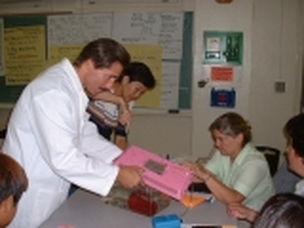2012 Annual Banquet Speaker
Neuron to Brain: Connectivity Impact on 21st Century Worldlings
Dr. Robert E. Landsman

Should teachers be called neuroeducators? It is known that the structure and function of our brains define much about how we learn and think. Yet, science is showing that the reverse effect also holds true—an environment that encourages learning and thinking can alter the connectivity of neurons and functioning of the brain. This impact will prepare our nation's youth to compete and succeed in the connectivity-driven 21st Century and may even lead to a healthier brain through old age. Some of the most recent compelling neuroscience findings on how thinking and learning are influenced by and influence the brain to promote the teacher to the role of neuroeducator will be presented.
Dr. Robert E. Landsman has worn two science hats over his career. He has practiced as a neuroscientist for twenty-three years and for the past twenty years has been dedicated to revamping our nation’s science education through a number of venues. He is the founder and president of ANOVA Science Education Corporation, a company devoted to the improvement of teaching of science from kindergarten through the university levels.
Dr. Landsman has extensive experience in K-12 scientific inquiry-based curriculum and program development across all grade levels, augmented by a vast array of teaching positions and experiences from the middle and high school levels to the university undergraduate and graduate levels. The Research Investigation Process, or RIP®, model that he developed was given the impact evidence-based distinction of Exemplary Science Education Program by the National Science Teachers Association in 2006.
The RIP uses a scientific inquiry-based critical thinking approach for the instruction and learning in STEM and non-STEM content areas. This approach to K-12 education has led teachers and their students to successfully raise the bar at both the school and professional levels. Not only does it raise measurable student achievement on many levels, but their accomplishments have consistently led both teachers and their students to present or publish their work in refereed venues.
Dr. Landsman has published and presented numerous papers and book chapters in the field of neuroscience and on science teaching and curriculum development. Between 2005-2006, he authored three books on scientific inquiry: RIP-ing Through Scientific Inquiry, Data Analysis and Decision Making in Scientific Inquiry, and Look at Me Now: Motivate Young Minds to Think and Learn Through Scientific Inquiry. He is the recipient of a number of awards and recognitions in both science and education, received his PHD in biopsychology/neuroscience from the Graduate Center of the City University of New York in conjunction with the American Museum of Natural History, and was a Post-Doctoral Scholar at both the UCLA School of Medicine’s Brain Research Institute and the Laboratory of Neuroendocrinology.
A familiar face at the NJ Science Convention, Dr. Landsman has consistently contributed as a presenter to teachers. Join us, as he wears his two hats, neuroscientist and educator, as our banquet speaker this year.
Dr. Robert E. Landsman has worn two science hats over his career. He has practiced as a neuroscientist for twenty-three years and for the past twenty years has been dedicated to revamping our nation’s science education through a number of venues. He is the founder and president of ANOVA Science Education Corporation, a company devoted to the improvement of teaching of science from kindergarten through the university levels.
Dr. Landsman has extensive experience in K-12 scientific inquiry-based curriculum and program development across all grade levels, augmented by a vast array of teaching positions and experiences from the middle and high school levels to the university undergraduate and graduate levels. The Research Investigation Process, or RIP®, model that he developed was given the impact evidence-based distinction of Exemplary Science Education Program by the National Science Teachers Association in 2006.
The RIP uses a scientific inquiry-based critical thinking approach for the instruction and learning in STEM and non-STEM content areas. This approach to K-12 education has led teachers and their students to successfully raise the bar at both the school and professional levels. Not only does it raise measurable student achievement on many levels, but their accomplishments have consistently led both teachers and their students to present or publish their work in refereed venues.
Dr. Landsman has published and presented numerous papers and book chapters in the field of neuroscience and on science teaching and curriculum development. Between 2005-2006, he authored three books on scientific inquiry: RIP-ing Through Scientific Inquiry, Data Analysis and Decision Making in Scientific Inquiry, and Look at Me Now: Motivate Young Minds to Think and Learn Through Scientific Inquiry. He is the recipient of a number of awards and recognitions in both science and education, received his PHD in biopsychology/neuroscience from the Graduate Center of the City University of New York in conjunction with the American Museum of Natural History, and was a Post-Doctoral Scholar at both the UCLA School of Medicine’s Brain Research Institute and the Laboratory of Neuroendocrinology.
A familiar face at the NJ Science Convention, Dr. Landsman has consistently contributed as a presenter to teachers. Join us, as he wears his two hats, neuroscientist and educator, as our banquet speaker this year.